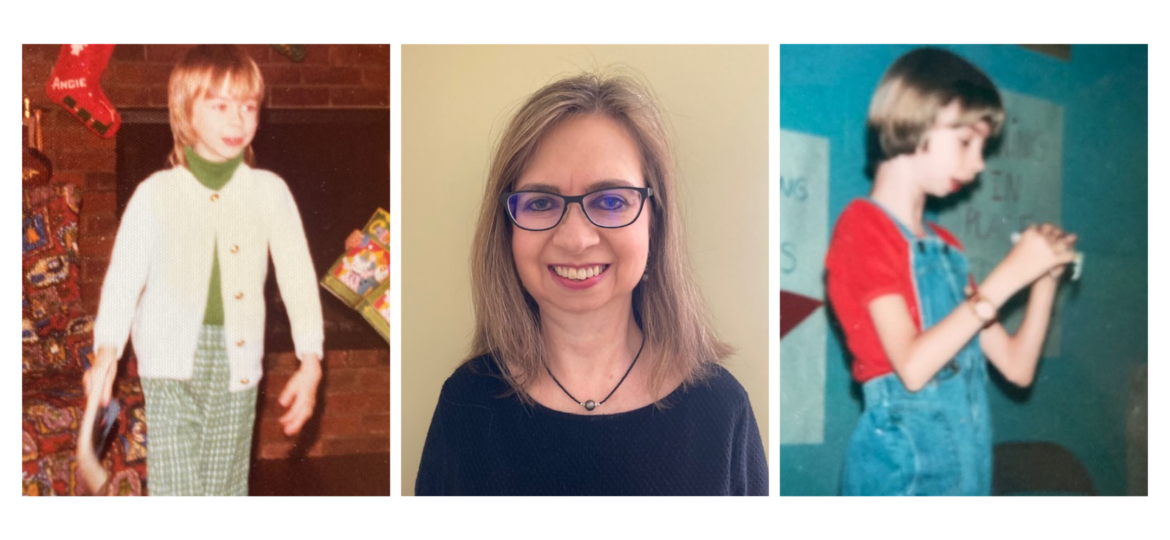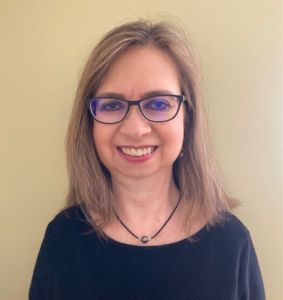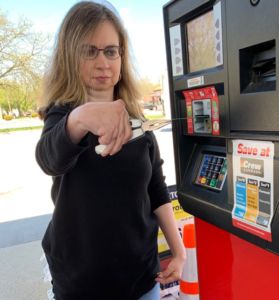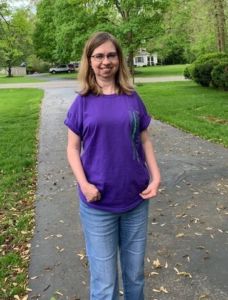
5 Questions with Stephanie Groves is an ongoing series featuring local women doing interesting things that we’d like to know more about. Want to be featured? Email us at editorial@indymaven.com.

There are more than 100 different types of arthritis that affect people of all ages. In fact, according to the Arthritis Foundation, two-thirds of people with arthritis are under the age of 65, including 300,000 children.

Angie Harrison of Indianapolis was one of those children diagnosed with arthritis. Harrison was diagnosed with juvenile arthritis 51 years ago at the tender age of 3½ after she began complaining of pain when doing activities like walking or grasping onto something. Soon multiple joints, and eventually all of her joints, were affected.
Back then, baby aspirin was the only treatment for children, so the symptoms were addressed but not the arthritis, leading to significant joint deformity. Despite the limited range of motion and pain, she strove to do as many of the activities that other children did as she could.
Through the years Harrison has made staying independent a priority. It was important to her to gain a college degree, which she obtained from Butler University, as well as a graduate degree in social work from Indiana University. Harrison was also able to move out on her own and pursue a career in medical social work.
Now, she has accepted the role to serve as 2022’s national Walk to Cure Arthritis Honoree. As the National Honoree, Angie will help raise awareness of the impact of the disorder on children, adults, and communities, and promote the Arthritis Foundation’s tools, resources, science, and advocacy initiatives—all of which help people live better while searching for a cure to the number one cause of disability in the United States.
We spoke to Harrison to learn more about her experiences and triumphs. And if you’d like to help, sign up for the 2022 Walk to Cure Arthritis in Indianapolis, held Friday, May 13, at Conner Prairie.
You were diagnosed with juvenile arthritis 51 years ago at age 3 ½. Can you explain more about how you were diagnosed and treated?

After I began complaining of pain in my knees and hands, my mother took me to our family doctor in Columbus, IN who suspected juvenile arthritis and sent me to Riley Hospital for Children in Indianapolis. Through blood tests and X-rays, I was quickly diagnosed with polyarticular juvenile arthritis.
At the time of my diagnosis in 1971, my treatment consisted of taking baby aspirin to treat the swelling and pain. Baby aspirin did nothing to fight the arthritis and the joint destruction. Fortunately, there are disease-modifying drugs now to help prevent the joint deformities, with which I deal. I also saw an occupational therapist for hand splints in the early years to hold my wrists in position to assist with alignment at night. I remember not liking the splints and figuring a way to get out of them at night using my teeth to undo the Velcro straps.
What are some of the biggest challenges that you have overcome due to having arthritis from such a young age?

Through the years the challenges have changed. When I was school age, the arthritis was the most active, but I continued to attend school, ride my bike, play with friends, and do many of the activities the other kids did.
For me the mornings were the hardest due to stiffness and pain; I would often have my little brother help me put on my socks. This memory is bittersweet.
I was not able to sit on the floor without great difficulty, so I would be given a chair to sit in while the other kids sat on the floor. Because I did not want to be treated differently, I always hated it when an activity had us sit on the floor, which is quite often in elementary school. In high school, my greatest challenge was seeing a future for myself. I was afraid that I could not physically be independent enough to drive, go to college, or live on my own.
In my twenties, I began having joint replacement surgeries. While a sophomore in college, I had my right hip replaced. A couple of years into working, I had both knees replaced.

Maintaining my ability to work was a challenge due to fatigue and pain. The unpredictability of arthritis makes it difficult to plan your life at times. Will it be a “good” day or “bad” day? If I do this activity, will I be able to function the next day? In 2015, I experienced my first arthritis flare as an adult. I gained a new appreciation for what I dealt with as a child, but now as an adult, I was living on my own and working. As a result of this flare, I medically retired in 2017.
When I was younger, I fought to do things as “everyone else.” For many years this created additional stress and kept me from doing some things. My ultimate drive to remain independent helped me grow into myself.

I now do whatever I can, however I can, even if it looks different from others or takes longer than others. Giving myself permission to use assistive devices like a scooter at work, a sock aid, a reacher, jar opener, long-handled toenail clippers, and many others, diminished the physical stress and emotional power of my gnarled fingers, twisted ankles, frozen neck, bent elbows, and other joint deformities in my life.
What are you most proud of accomplishing with arthritis?
In general, I would say that my arthritis, the damage to my joints, has gotten worse over my life but my ability to accommodate and reframe has allowed me to thrive. I am proud that I keep going. I am proud that after losing my career as a medical social worker to the impact of living with arthritis, I sought out another way to help others within my abilities as an active volunteer with The Arthritis Foundation.
What would you like people to know and understand about arthritis?
Arthritis affects 1 in 4 people and people of all ages. There are over 100 types of arthritis including rheumatoid arthritis, osteoarthritis, gout, lupus, and psoriatic arthritis. Arthritis is not a disease that only “old” people get.
I heard, “You are not old enough to have arthritis” a lot when I was growing up. Arthritis can be a “hidden” disease now for some. The disease-modifying medications available today lessen the joint damage/deformity that is done, which makes it hard for people to see and thus understand a person’s limitations from fatigue or pain.
It is important that people know that The Arthritis Foundation is available to help people living with arthritis live their best life with information, resources, connections, and research.
What can others do to help raise awareness?

A big way to help raise awareness for juvenile arthritis is to support The Walk to Cure Arthritis, The Arthritis Foundation’s signature event to raise awareness, to celebrate arthritis warriors, and raise funds for better treatments and a cure. The Walk is May 13 at 5:30 p.m. at Conner Prairie in Fishers, Indiana. We are excited to be able to have an in-person Walk this year and hope you will join us.
Stephanie Groves is the Executive Editor of Indy Maven.
All of our content—including this article—is completely free. However, we’d love it if you would please consider supporting our journalism with an Indy Maven membership.






